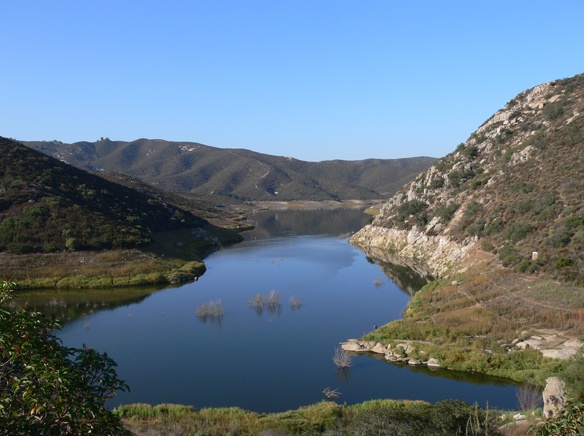Serving more than 200,000 residents in the county, the Sweetwater Authority extended it recreational activities at both of its reservoirs. Camping, horseback riding, hiking, biking and shoreline fishing are open to the public, and the Authority is welcoming the public to enjoy the outdoors at the Sweetwater Reservoir in Spring Valley, and the Loveland Reservoir, just south of Alpine. Each location has its own distinct experience.
“Though it is more remote, Loveland is more rugged, further away from civilization, giving a more isolated feel to it,” said Sweetwater Authority Governing Board Chair Hector Martinez. “You can walk to Sweetwater. It is close, surrounded by a county park, nearby a freeway, and a lot more urban. But it is much bigger than Loveland and has quite easy access.”
Martinez said expanding its recreational activities during the pandemic, when experts are encouraging people to do safer outdoor activities, hopefully helps the health, mental and physical issues associated with months of restrictions and lockdowns.
“We felt it was the right thing to do as people who like to serve the community,” said Martinez. “We are elected officials and elected to serve the public. We can serve them better by opening, spending money, and expanding these recreational programs that we have. Not everybody has a reservoir. We are blessed by having Loveland Reservoir and the Sweetwater Reservoir. Through research and studies, we have conducted recently, we discovered that people do not know about these programs. They do not know about all the facilities that we have. It is like a little secret that has been around. Maybe some old timers remember fishing at Sweetwater, but then it was closed off. We want to reverse that, open it up to the people, and in the future, even more.”
Martinez said that there is much more to the reservoirs than fishing. An avid mountain biker and hiker, he said the trails at both reservoirs are beautiful and abundant with wildlife.
“I’ve been on mountain bike rides and run into a family of bobcats, or deer and coyotes,” said Martinez. “There are all these different types of wildlife out there, in our back yards when you go around these reservoirs. For me it is unusual and exciting to be out there in nature. Right now, the focus is the fishing program and hopefully, later, we can do more things with the trails working with the county of San Diego and environmental agencies.”
Loveland has daily fishing at Loveland from 6 a.m. – 6 p.m. Sweetwater’s fishing program is open three days a week, Saturday through Monday. Leslie Payne, Sweetwater Authority Public Affairs manager said with Sweetwater, the Sweetwater Summit Regional Park campground brings many people hiking and fishing at the reservoir.
“Another interesting thing about Sweetwater is that many people bring their horses out,” said Payne. “It has great horse trails. It is really beautiful out there, especially this time of year.”
At Loveland, there is no charge to fish. At Sweetwater there is a charge for fishing. There is a kiosk where people pay. It is all cash. There is an envelope to make payments and it costs $5 per person, per day. Loveland and Sweetwater are known for catching bass, catfish, bluegill, red eared sunfish, and crappie. The reservoirs are not pre-stocked with any fish.
“You do have to have a fishing license, and purchase that prior to visiting the facility,” said Payne. “We do not sell bait. Everyone brings everything they need with them.”
Payne said licenses can be purchased at local bait shops and Wal Mart. Anyone 16 or older is required to have a fishing license.
Payne said both sites have staff patrolling, answering questions, assisting the public, getting fish counts, and chatting with the anglers to see what they are catching.
“With the fishing program at Loveland, you must hike in a way,” said Payne. “So, if you have little kids, Sweetwater may be easier. But for older kids who like the hike. Loveland is beautiful. Because it is all shoreline fishing, there is easier access, but both programs are great. They offer different fish that are caught at each location. So, it really comes down to what kind of experience you are looking for.”
Payne said the trails are maintained, cleaned, and have access for all hiker abilities.
“Both facilities have really nice, maintained accessible trails,” she said. “There are areas in both facilities where we have many different biological factors. We have a biologist on staff. We are very mindful of the balance of both human and environmental needs at both facilities. They are both drinking water facilities, so in addition to being a place of recreation for the public, the goal is to keep the water clean and safe. We are grateful for people to use the trails and fish. We ask people to pick up their trash and remind them that they are in the watershed at that time and enjoy it, but also take good care of it.”
Martinez said the Authority sees this as another way of providing services for the wellbeing of the community.
“I want people to feel welcomed,” he said. “People have these great publicly owned facilities, and we are making them available as much as possible. It is safe, affordable, so please come by and enjoy it.”
We take this as a serious responsibility and now we are acting on this. Expanded hours, expanded days. I encourage all the public that can, whether you are in our service area or out of our service area, to take advantage of this. Hopefully catch some good fish, go on some good hikes.”
For more information, visit www. sweetwater.org/255/fishing.














What were you thinking??? Mountain biking and trail-building destroy wildlife habitat! Mountain biking is environmentally, socially, and medically destructive! There is no good reason to allow bicycles on any unpaved trail!
Bicycles should not be allowed in any natural area. They are inanimate objects and have no rights. There is also no right to mountain bike. That was settled in federal court in 1996: https://mjvande.info/mtb10.htm . It’s dishonest of mountain bikers to say that they don’t have access to trails closed to bikes. They have EXACTLY the same access as everyone else — ON FOOT! Why isn’t that good enough for mountain bikers? They are all capable of walking….
A favorite myth of mountain bikers is that mountain biking is no more harmful to wildlife, people, and the environment than hiking, and that science supports that view. Of course, it’s not true. To settle the matter once and for all, I read all of the research they cited, and wrote a review of the research on mountain biking impacts (see https://mjvande.info/scb7.htm ). I found that of the seven studies they cited, (1) all were written by mountain bikers, and (2) in every case, the authors misinterpreted their own data, in order to come to the conclusion that they favored. They also studiously avoided mentioning another scientific study (Wisdom et al) which did not favor mountain biking, and came to the opposite conclusions.
Mountain bikers also love to build new trails – legally or illegally. Of course, trail-building destroys wildlife habitat – not just in the trail bed, but in a wide swath to both sides of the trail! E.g. grizzlies can hear a human from one mile away, and smell us from 5 miles away. Thus, a 10-mile trail represents 100 square miles of destroyed or degraded habitat, that animals are inhibited from using. Mountain biking, trail building, and trail maintenance all increase the number of people in the park, thereby preventing the animals’ full use of their habitat. See https://mjvande.info/scb9.htm for details.
Mountain biking accelerates erosion, creates V-shaped ruts, kills small animals and plants on and next to the trail, drives wildlife and other trail users out of the area, and, worst of all, teaches kids that the rough treatment of nature is okay (it’s NOT!). What’s good about THAT?
To see exactly what harm mountain biking does to the land, watch this 5-minute video: http://vimeo.com/48784297.
In addition to all of this, it is extremely dangerous: https://mjvande.info/mtb_dangerous.htm .
For more information: https://mjvande.info/mtbfaq.htm .
The common thread among those who want more recreation in our parks is total ignorance about and disinterest in the wildlife whose homes these parks are. Yes, if humans are the only beings that matter, it is simply a conflict among humans (but even then, allowing bikes on trails harms the MAJORITY of park users — hikers and equestrians — who can no longer safely and peacefully enjoy their parks).
The parks aren’t gymnasiums or racetracks or even human playgrounds. They are WILDLIFE HABITAT, which is precisely why they are attractive to humans. Activities such as mountain biking, that destroy habitat, violate the charter of the parks.
Even kayaking and rafting, which give humans access to the entirety of a water body, prevent the wildlife that live there from making full use of their habitat, and should not be allowed. Of course those who think that only humans matter won’t understand what I am talking about — an indication of the sad state of our culture and educational system.